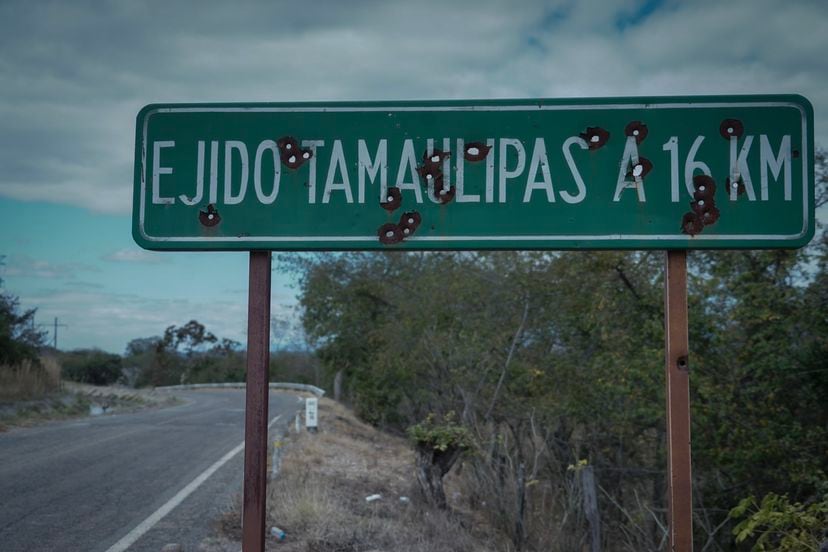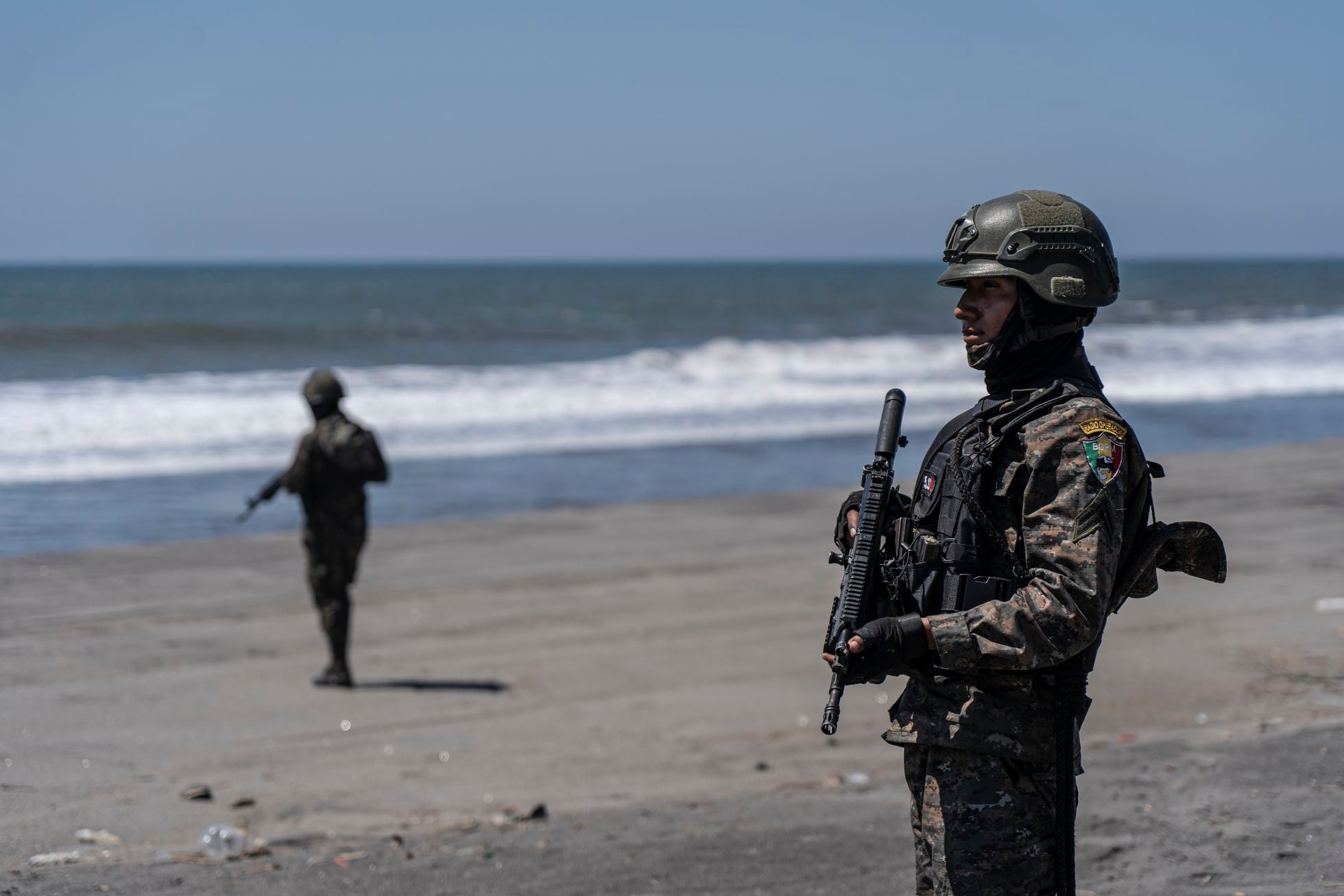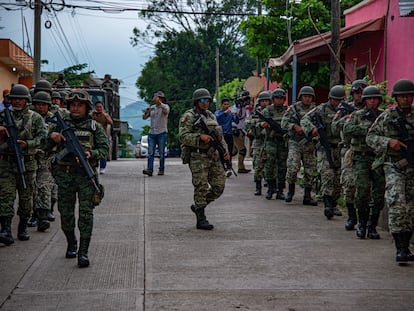Chiapas, captive territory
EL PAÍS travels along the border of the poorest state in Mexico, a region dominated by criminal groups. From the city of Tapachula to the Lacandon Jungle, passing through the towns of Frontera Comalapa and Chisomuselo, this story illustrates the fight between cartels, the abandonment of the state, the murders, forced displacements, kidnappings and extortions, along with the efforts made by the local and migrant populations to survive
Members of a Venezuelan family — en route to the Mexican city of Tapachula — are locked in a rooster cage, awaiting their turn to leave. An old man, frozen from the cold, remembers his escape from his hometown near the border with Guatemala, under the threat of organized crime. A group of sharecroppers, including both teenagers and elderly people, are armed with worn-out hunting rifles and late-model machine guns: they cook over embers, while guarding the entrance to the town of Frontera Corozal. Meanwhile, a Guatemalan colonel and his brigade guard the mouth of the Suchiate River, which flows into the Pacific. “Here,” he notes, “you’ll find all kinds of trafficking: drugs, weapons, people.” Several men disguised as police officers, with guns on their belts, burst into Nueva Palestina with a message: from that moment on, they’re the ones in charge. And, one of the few residents left in the municipality of Chicomuselo — located in the center of the battle between cartels — murmurs a dangerous preference: “Members of the Sinaloa Cartel came here and asked us for support. We gave it to them.”
These six images — distributed along nearly 400 miles of the border between Chiapas and Guatemala — illustrate the ongoing battle for control over the poorest Mexican state. Chiapas is a disputed territory, victim of the struggle between the two most powerful criminal groups in the country: the Sinaloa Cartel and the Jalisco New Generation Cartel (or the CJNG, its acronym in Spanish). Amidst the fighting, the population is trying to survive, trapped in an armed conflict reminiscent of what has gone on in the states of Tamaulipas, Michoacán or Guanajuato — a kind of violence that was foreign to Chiapas until recently. The cradle of the last guerrilla movement that was born in the Americas — an image of the country’s inequalities, adventure tourism and extreme poverty —, Chiapas now looks to the border with Guatemala and its trail of murders, kidnappings, forced displacements and extortions.
The aforementioned scenes illuminate a month-and-a-half-long journey taken by six reporters from EL PAÍS through the geography of the conflict, from Frontera Corozal and Nueva Palestina to Tapachula and the mouth of the Suchiate River, passing through the towns of Frontera Comalapa and Chicomuselo, to the mountains of the Sierra Mariscal region, right up against the Guatemalan border. The dozens of testimonies collected by this newspaper illuminate the terror and paranoia experienced by the population, who feel abandoned by the Mexican state.
During the journey, the presence of the authorities is intermittent. The Mexican Army, the National Guard and the police arrive when something has already happened — always too late. The locals look on with distrust, as if those in uniform are also part of the problem.
Documents from the Ministry of National Defense — leaked by the Guacamaya hacktivist group — show the dominance that the Sinaloa Cartel had over criminal activity in the state of Chiapas up until 2022. Around then, the organization suffered a split, following an internal dispute. The CJNG took advantage of the opportunity to infiltrate territory along the Pacific coast, before launching its tentacles towards the north. Lantia Consultores — a firm specializing in organized crime movements in Mexico — confirmed these shifts when consulted by EL PAÍS.
A war has emerged as different groups attempt to gain control over the illicit businesses in the poor border region. The trafficking of migrants and drugs is rife, as is competing influence as Mexico gears up for elections this June. NGOs monitoring the situation define it as an “unrecognized armed conflict.” According to calculations by the Fray Bartolomé de las Casas Human Rights Center, to date, the battle has driven at least 10,000 people from their homes in the central border region alone. The federal and state governments are trying to downplay the reality, even going so far was to call Chiapas a “peaceful state.” However, the Zapatista National Liberation Army (EZLN) refers to what is happening as a civil war.
Confusion underlies tragedy. In various towns and communities in Chiapas — such as Chicomuselo and Frontera Comalapa — farmers and residents prefer the Sinaloa Cartel. In their eyes, the CJNG embodies evil, extortion, and another thousand reasons to flee. In the Lacandon Jungle, Sinaloa dominates without having to make much noise. However, on the coast, the old unity of the Sinaloa Cartel has broken down: different factions are now fighting to maintain control of the Suchiate River and the trafficking routes that leave Tapachula to the north.
In all regions, testimonies indicate that it’s sometimes very difficult to know who is who. Meanwhile, between the cartels and their disputes, the residents, migrants and captives are caught in the crossfire.
“El Maíz,” the social arm of the Jalisco New Generation Cartel
Not a soul walks down the sorrowful streets of Nueva América. In the town, there’s hardly any bustle of people or livestock. Much of the agricultural land has been abandoned. Some dogs wander over the dirt floor, either bewildered or bored. On the way to the dam, the shell of a foreign-made truck embodies the confusion and anxiety of those who remain. No one knows how the vehicle got there: nobody knows who it belonged to nor why it was abandoned. In the central border region of Chiapas, it’s a trend these days to ignore things and keep silent.
In a corner of the central plaza, two men murmur. They see the newcomers from this newspaper: one goes back inside his house. The other man stays put. He’s the only resident on the street for a mile. “That’s where the groups got down [from their vehicles],” he recalls, cautiously tilting his chin in the direction of the road that leads to the dam, where the burned-out truck lies. “They bumped into each other,” he explains, as if they were two friends who had met. But in fact, the fork in the road he points out is where the last shootout between the Sinaloa Cartel and the Jalisco New Generation Cartel (CJNG) took place.
The incident happened on January 15, and it wasn’t the first time. For a year-and-a-half, the battle along the border between Chiapas and Guatemala has kept dozens of communities — such as Nueva América — in a state of terror. It’s an old battle in a new setting. According to reports from Lantia Consultores, “the CJNG has gradually moved from [the town of] Tapachula to the north [of the state] — where the Sinaloa Cartel used to have a very strong presence — and towards the central border. The clashes that we’ve seen in the area are the result of that [expansion].”
EL PAÍS collected 15 testimonies from the towns of Nueva América, Chicomuselo and Frontera Comalapa at the beginning of February. Among the displaced populations of those communities and other cities — such as Tuxtla, the capital — fear is rampant. Their names don’t appear in this piece, to protect them from any type of retaliation for speaking out. “Everything is very tense, we’re surrounded,” says a woman in Chicomuselo one morning, in a quiet voice. “They wanted us to commit to working for them, as bait,” laments a man who was displaced from Bella Vista, the neighboring town. He spoke to EL PAÍS on a windy night in Comitán, where he has taken refuge.
The frontlines run between the southeastern slope of the local dam — La Angostura — and the mountains of the Sierra Mariscal region. The centers of towns like Chicomuselo — located on the slopes of a mountain — seem trapped in an eternal Sunday afternoon: the streets are empty and most businesses are shuttered. The rural villages are practically unreachable, with armed groups having installed checkpoints everywhere. Operating like police officers, they stop travelers, ask for their credentials and take photographs of them. From the cities of La Trinitaria to Motozintla, passing through the towns of Frontera Comalapa, Chamic, Amatenango, Chicomuselo and Sultepec, both cartels are constantly battling over the border region’s wealth.
Then, there’s the propaganda — the tricks of the CJNG and the Sinaloa Cartel — which is deployed to get the residents on their side. Unlike what the cartels have done in other parts of Mexico, on the central border of Chiapas, where the social fabric is rich and deep, the armed groups seem to have adapted to the local way of life. The testimonies collected indicate, for example, that the CJNG disguises itself as a social organization — or uses a social organization in the area, or a mixture of both — to convince people (or force them) to integrate into its structure.
“El Maíz” (or “The Corn,” in English) is what the locals call this social arm of the CJNG. The man who fled Bella Vista was referring to El Maíz when he mentioned how the cartel was trying to get residents of the town to work for them. He explains how, one day, in December of last year, people from that group showed up and tried to get each person to “sign a paper.”
“They wanted us to go with them, to give them food, to support them. But we wouldn’t get any benefits out of that. So, people began to leave the community,” he explains. The irony is terrible: in a region that relies on subsistence agriculture, crime has perverted the relationship between a revered crop — corn — and the word for it.
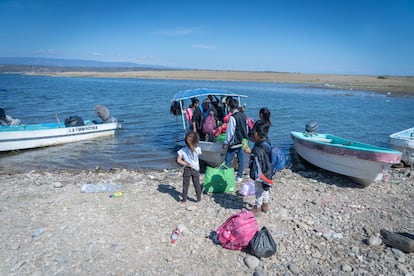
The only man on the street in Nueva América points out the cartel’s tactics. “Two days before the [shootout], guys from the Sinaloa Cartel had already come here to talk to the people,” he notes. “We agreed with them, because we didn’t want El Maíz to enter [the town],” he adds. The man says that the meeting that Sinaloa called had a very clear objective: that, when El Maíz arrived, the residents would block the way. From what he recalls, there were no doubts, nor resistance. It was simply part of the natural state of things.
This apparent acceptance of the Sinaloa Cartel is heard with some frequency along the border region. Broadly speaking, the residents view the group favorably and distrust the CJNG. “We don’t want El Maíz here,” says the man from the central plaza. “Those from Sinaloa don’t force you to go along with them. If you want to, OK, but if not, no problem. But the other [cartels] force you to [participate],” he clarifies. “Participating” with a cartel implies taking part in roadblocks, paying fees, or feeding the narcos.
A resident of Frontera Comalapa describes the situation in their municipality — the most important in the region, a stronghold of El Maíz — which is surrounded by the Sinaloa Cartel. “It’s quiet here now, because everything is controlled by El Maíz. All merchants [and] all truck drivers are forcibly integrated into this organization. Everything depends on them. The last elections didn’t take place: the ballot boxes disappeared and it was agreed upon to set up a government council whose members belong to [the CJNG],” he says.
It’s not clear if the residents of Nueva América closed the passage to the CJNG on the day the Sinaloa Cartel requested it. But everyone agrees that on Sunday, January 14, the tension could be cut with a knife in the area. A religious man who frequents the region recalls how, by that day, the Sinaloa Cartel had already blocked off some roads. A resident displaced to Comitán says that, at night, shots began to be heard at the entrance to the community. Another remembers: “I left there on Monday afternoon and, just when we arrived at the dam, they began to shoot at each other… veryone got away as best they could.”
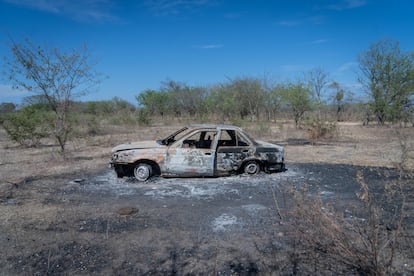
As the hours passed, the situation became more confusing. On Tuesday morning, the Mexican Army arrived in the community. However, instead of feeling relief, the residents saw the soldiers as a threat and gathered at the entrance of the town to prevent them from advancing. A battle broke out: videos on social media show residents throwing stones and soldiers firing tear gas. On the road that leads through the town, tree trunks were laid down to block the path of vehicles — the military removed them with a chainsaw. Hundreds of residents left the community over the course of those days.
Why didn’t they want the soldiers to enter? Residents of Nueva América — deeply faithful people who have suffered displacement — give a surprising response. According to them, the Army paves the way for the CJNG. “We didn’t want the military to enter — we don’t trust them. Behind them come the others, all mixed up,” says one man, in Comitán. “People from other communities have already told us that [the soldiers] make way for the [CJNG narcos]. They show up and charge a flat fee,” says another woman, also in Comitán.
Of course, there’s no evidence that this happens. And there’s also no remaining sign of the battle that took place in Nueva América: there’s a single black SUV making its way to the dam, amid the lack of sounds. On the fork in the road, the burned-out truck resembles the skeleton of a cow. Few images better represent oblivion than those bones made of rusty iron.
A weaponized jungle
North America’s last frontier is a twisted gash that cuts through the land, dividing the world in two. Here, in Frontera Corozal — a town made up of the Indigenous Ch’ol people in the heart of the Lacandon Jungle — they call it the Usumacinta River. Its pier has been the gateway for thousands of people travelling from Central and South America to Mexico for decades — it’s the penultimate stop on the odyssey north.
Many residents prospered from the businesses (some in the gray zone between being legal and illegal) that sprung up with the arrival of the migrants. Others simply got used to hearing different accents passing through. The pier became a hub of people and opportunities that attracted all types. Today, however, it’s empty. The shadow of war forced it to close. Boats have been left stranded on the sandy shore. In the afternoon, only howling monkeys can be heard.
Some farmers guard the pier. They wear exercise shirts, faded caps and ranch boots. All of them are armed: some with old hunting rifles, others with the late-model submachine guns, purchased from Guatemalan mafias. Had they been born in more fortunate circumstances and geographies, many of these men would have been savoring retirement long ago. But months ago, they had to abandon their crops and become militiamen.
One of the men, Alberto, is 73 years old. He has a hunting rifle strapped across his back. A man who doesn’t understand war, he’s familiar with the sweat on his forehead while working in the fields. He used to live in peace — and here, that means living with your back bent over the Earth until you die. One of the younger men, Andrés, age 26, voted for López Obrador, but he says that the president’s “hugs, not bullets” motto doesn’t work in Chiapas. There’s Fidencio, 58, who says that he doesn’t want to kill anyone — just reap his harvest. And then, there’s Carlos, 75, who’s been in the Lacandon Jungle for half-a-century. He wonders aloud why bad people come to mistreat his community.
This group of men is known as the “community guard.” Locals say that it’s the only body that keeps the decay brought by the cartels at bay. They don’t want their home to become a battlefield, as has happened on the northern border of Mexico, a desert that has become synonymous with horror. The members of the community guard are farmers, not soldiers, but who else is going to defend the town if the bad guys return, when the government does nothing?
Alberto doesn’t like strangers or their questions. Before speaking to EL PAÍS, he asks for IDs, passports and press cards. While it appears that the Sinaloa Cartel has been expelled from the town, paranoia and fear remain among the inhabitants of the jungle.
Whenever the elderly man dares to respond, he does so in the Ch’ol language — he doesn’t speak Spanish. One of his younger companions translates: “Crime entered [the town] freely, with weapons, trafficking, murders. The state police got involved with the bad guys. They charged the undocumented. The Prosecutor’s Office also collected its bribes. The cartels had never gained so much ground. I’m old, but I’m going to die here, in the [community] guard, because I don’t want [the narcos] to harm our grandchildren, our future.”
In the Lacandon Jungle, the war is more discreet than in the rest of Chiapas. But subtle psychological terror is a powerful weapon: of the dozens of people interviewed by this newspaper — most of them social leaders and farmers who have been forced to flee — only a handful dare to give their names. Fear has spread like the delirium of a tropical fever.
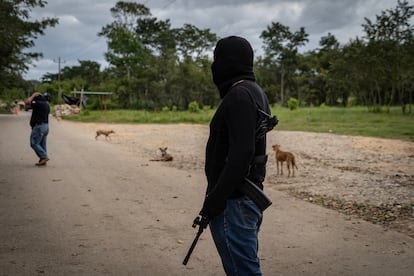
The Lacandon Jungle doesn’t have a history of peace. Communities residing in the jungle are poor: most are dispossessed Indigenous people, whose land has been occupied by chiefs who refuse to leave them. The west is the bastion of the Zapatista Army of National Liberation — the inevitable reaction (in guerrilla form) against centuries-old misery. The isolated jungle has always been a fertile region for illicit commerce: since drugs became a profitable business, planes loaded with cocaine have landed on clandestine airstrips, under the cover of trees. Coyotes (people smugglers) travel the roads at will, driving trucks packed with migrants. Violence, however, hasn’t overwhelmed the region as in other parts of Mexico. The current conflict is new: the bubble only burst last September.
When the men from the Sinaloa Cartel arrived at Frontera Corozal, they claimed to be envoys from the government. They then asked for lists of businesses to collect fees. The Indigenous authorities didn’t pay any attention to them. Then, the first kidnapping occurred. Followed by the second. Then the third.
Since they couldn’t trust the state or rural police — both on the cartel’s payroll — the assembly decided to organize the community watch. Since then, the farmers have guarded two entrances to the town: the pier and the road. All male residents are obliged to participate in the defense, although some women have also joined. Any man who doesn’t participate must pay a fine.
The assembly appointed Esquivel Cruz to be in charge of keeping the peace and maintaining a dialogue with the government. Sitting on the porch of his house, he speaks with EL PAÍS: “We’re not prepared to be police officers — we’ve spent our lives working the fields. If Chiapas were at peace, we wouldn’t be doing this. We don’t want to leave the little that we have, because it has cost us a lot to build it up. It’s not life that we’re living; this is just the new normal for us. If we leave the guard, [the narcos] will enter the town and we’ll be the first people they kill.”
There’s total control in Frontera Corozal. Alcohol is prohibited. There’s a curfew. Everyone acts like the police: there’s no more gang activity, because any suspicious-looking youngsters are detained (those who dress in black, have tattoos, or appear aggressive). The residents are aware that they’ve renounced basic freedoms, but if conflict breaks out, they know that they’ll die. “We hold the federal government responsible. We’re exposing ourselves to a lot of [violence], but we have no other alternative,” Cruz laments. It’s the price to pay for this dirty peace that looks a lot like war.
The Sinaloa Cartel didn’t expect this collective response — the narcos didn’t know how to handle the mobilization of people who refuse to accept violence as part of their lives. A month before the cartel tried to breach Frontera Corozal, the same thing happened in Nueva Palestina, a town of bungalows, hardworking inhabitants, dirt streets and auto rickshaws. A group of men disguised as police officers burst into the authorities’ offices with guns attached to their belts. They said they were now in charge, but the people rebelled, calling for military intervention, holding demonstrations and setting up their own community watch. A tense calm settled in and, in the shadows, threats were made. Many people fled, hid, or suffered reprisals. Afterwards, nobody dared raise their voice. Life went on.
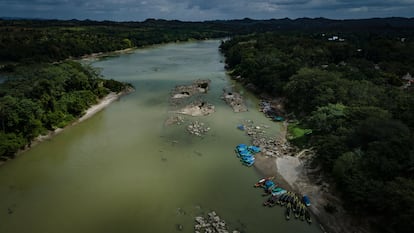
A hundred soldiers are stationed outside of San Javier, halfway between Frontera Corozal and Nueva Palestina, at the same crossroads where the cartels previously collected tolls from human traffickers. Even the soldiers are afraid. “There are large areas of Chiapas controlled by organized crime. Many of us are from the region or nearby — we have to protect our identities. Right now, [the cartels] are quiet, because we’re here,” one of them confesses. What the young man in uniform doesn’t mention is what goes on when there’s no military presence.
It’s a paradoxical situation: just a few miles from the military checkpoint — both in San Javier and the nearby community of Lacanjá Chansayab — is the epicenter of the cartels. Local bosses live there, including Cabrero Segundo or Hugo Chambor. There are also miserable villages like Bethel, with wooden cabins and dirt floors, where the criminals get their cheap labor and cannon fodder. Because of the jungle and the ancient Mayan archeological site of Bonampak, the area once attracted tourists. But, out of fear, the travel agencies no longer send visitors. The hotel zone is a ghost town. “I’ll never, ever join up with the cartels,” a hotelier vows, “but I can’t run away. They’ve threatened me: ‘Either you give in, or we’ll come for you.’ There’s no response from the government. And, without tourists, we’re losing one day at a time.”
The presence of the soldiers is mostly symbolic. They don’t intervene. Despite their presence, trafficking doesn’t stop. People survive however they can. Some flee. Others stare at the ground, learning to live in silence. Those who can organize themselves take up arms. They’re valiant: they swallow saliva and pray not to be around when the jungle spits out bullets. They feel alone. When night falls on the Usumacinta River, armed peasants cook in large cauldrons over embers on the ground. The monkeys continue howling.
The Suchiate River, a witness to crimes
Everyone saw him floating. Down the river, wrapped in garbage bags, his face sallow, his eyes closed.
His swollen features circulated on social media. Everyone recorded the corpse as it passed them by. But nobody knows anything about the victim. The journalists and the army don’t know; neither do the politicians, the farmers, or the boat pilots. Even the person who runs the cemetery has no idea.
Who was he, before he was thrown into the dirty waters of the Suchiate River? How did he end up there?
He was finally picked up at the end of the route, battered by the ocean, which returns everything that doesn’t belong to it: garbage and offerings. Some say that his drenched body is still at the Tapachula Forensic Service. Unidentified, he will soon end up in a mass grave — the place where those who die without a name are buried in this border region.
The investigation — kept in a folder that bears a number — hasn’t been able to answer who he was or why he was killed. The fierce logic of a war is stamped on his body, now in Chiapas. Everyone saw him; no one recognized him.
The Suchiate River rises on the slopes of the Tacaná Volcano and reaches the Pacific Ocean. Its dark water separates Guatemala and Mexico. It’s because of this river that Tecún Umán (Guatemala) and Hidalgo (Mexico) are two different cities. They’re the doors, while the river is the hallway. Each week, thousands of trailers carrying goods are hauled on the bridge that runs over it. Everything else crosses the water. The Guatemalan Army and Mexican politicians describe it the same way: this is a porous boundary for weapons, drugs and people.
For decades, the border was managed by the Sinaloa Cartel (on both sides). In the city of Tecún Uman, Erick Suñiga — alias “El Pocho” — ruled the area for 11 years, posing as a pastor, businessman and mayor. He was extradited to the United States at the end of 2019 for his ties to drug-trafficking, dying a few months later. Today, his daughter — Isel, a former Miss Guatemala — now runs her deceased father’s affairs. “The area is filled with [narcos] from the [CJNG] and Sinaloa Cartel. They can’t control themselves,” a reporter shrugs. He recalls how 200 bullets were fired at the director of the municipal police. Monopolies are better facilitators for peace.
The same thing goes on in Mexico; you just need to change the names. A few months ago, the mayor of Suchiate, Sonia Eloína Hernández — alias “La Chona” —, asked mothers to take care of their children, because “this is out of control.” She even pleaded with the narcos: “Behave well, and whoever behaves badly, please, I ask you to respect your fellow citizens.” Shortly after this, she expressed anger at the U.S. State Department placing a travel warning on her municipality.
Over thunderous music, in an empty bar with very high green walls, two politicians — who were once linked to the Hidalgo City Council — speak to EL PAÍS about the prevalence of fear in the state of Chiapas. In January, David Rey, an opposition candidate in the Suchiate mayoral election, was shot dead. He was assassinated after visiting an area where Xóchitl Gálvez — the main opposition candidate contesting the 2024 presidential elections — was scheduled to hold a rally just a few days later. “This area is no longer controlled by the government,” the former officials note. When asked who’s in charge, they reply: “Sinaloa.”
“Tío Gil” — one of Joaquín “El Chapo” Guzmán’s trusted men — managed the trafficking entrance into Chiapas for years. In 2016, he was arrested in Guatemala and extradited to the United States for cocaine distribution. His son succeeded him: “El Junior.” But a commando killed him in 2021, complicating the hierarchy.
The reporter in the city of Hidalgo faces many threats. He realizes that he’s only able to do his job half-heartedly. In exchange, he can still take his son to school. He lays out the scenario for EL PAÍS: two factions from the Sinaloa Cartel — one of them often being confused with the CJNG — have been fighting for a year-and-a-half over this entrance to Mexico. He whispers names and links: the bloodthirsty “El Botana,” who’s the brother of a mayor from the ruling party, MORENA; “El Memo,” who was arrested after making a pact with the authorities to save his own life; the so-called “Señor de los Caballos,” who’s in an all-out war against “El Güero Pulseras,” each mobster struggling to be the undisputed head of the Sinaloa Cartel in Chiapas. And then, there are those who remain in the shadows behind the big names: the drug dealers who traffic and die, the hawks who watch and die, the traffickers who drive trucks and die, the migrants who cross the river or the jungle and die. Was the man who was killed and dumped in the Suchiate River one of these anonymous people?
It hasn’t rained for months and the river can be crossed on foot. Even so, almost all migrants choose Guatemalan rafters: they get cheated on the price, but this way, they don’t risk their children, or the documents they’ve been carrying for thousands of miles. When they get across, they camp on the shores of the Mexican side: the National Migration Institute has set up a checkpoint there, which promises to bus the new arrivals to Tuxtla Gutiérrez, the state capital. But the wait is long, as there are many migrants and few buses. “Those who have money are transferred quickly… and those who don’t have any must endure until [there’s space],” summarizes Heyman Vázquez, a priest from Hidalgo. The prospect of a week waiting on a wet piece of cardboard — in front of a stinking river, underneath a blazing sun — forces many to begin the journey on foot. But the asphalt burns.
Genésis and her family were walking on the side of the road towards Tapachula when they were abducted. It was the end of February: they had left Caracas, Venezuela a couple of weeks earlier. Four motorcyclists approached and offered to take them part of the way. “They talked to us about God — that’s why we got on,” says this petite woman, who trembles as she tells her story. The drivers took them to armed men. “They locked us in some rooster cages.” They asked for 1,100 pesos per person (about $60) to free them. “But we didn’t have the money,” she cries. They spent hours caged with other migrants they didn’t know. She cannot identify the place: she only remembers that a mountain was visible. They released them when it was already nighttime. The captors kept two of the women. The rest arrived exhausted and lost at dawn at an immigration booth, where a sign greeted them. It said “Viva México.”
The road to the north — passing through Huehuetán, Huixtla, Mapastepec, Pijijiapán and Arriaga — is full of checkpoints. But the Mexican Immigration Service and the National Guard only detain migrants if they’re inside a vehicle — they let them pass if they’re on foot. “The government is betting that the migrants will become exhausted, physically and economically,” Father Heyman affirms. “[The authorities] are making a fortune on the migrants. The [human-traffickers] also give money to the authorities.”
This perilous route is an obstacle course: the human beings are prey as they stumble through the greenery of the banana trees. At the height of Mapastepec — a town that is partly in the Madre de Chiapas mountain range — Yamineth shows EL PAÍS a photo on her phone. It’s an ink tattoo of a phoenix on her forearm: she says that the cartel put it there.
The person who sold them like cattle was driving a gray truck. He was paid to transport the migrants for a few miles. “When they took us down, the first thing we saw were heavily-armed people wearing hoodies. They took us to a corner and told us: ‘This isn’t a kidnapping, as many people call it. This is so that you can travel through the town of Tapachula without anyone bothering you. We’re going to charge you 1,100 Mexican pesos ($60) — those who don’t have it won’t leave. Here, we have Western Union: we can receive any funds that you’re sent.”
They searched them, taped up their cell phones and locked them in a fenced pen, with roosters nearby. “There were children, tiny babies, just months old… There were people who had been there for three days,” she recalls. “We had the money. We paid and left.” For Yamineth, the north is still far away. She asks: “Is it true that it gets worse over there?”
In the Suchiate River, in the Lacandon Jungle and in the mountain towns of the Sierra Mariscal, life goes on, although everyone is looking behind their back, keeping their ears wide open, always alert. Despite this tension, the state and federal governments try to downplay the issue. For example, this past February, President Andrés Manuel López Obrador dismissed the complaints about insecurity as being part of a “media campaign” being waged against him. And, in January, the governor of Chiapas — Rutilio Escandón, a close ally of the president — assured the public that “in Chiapas, we live in peace.” There are figures that support such a statement: one can look to the relatively stable annual murder rate. But that stability only fuels the confusion. In many cases, victims don’t report the crimes that are committed against them. And generally, it seems that reality has surpassed the rule of law, which is dismissive of the forced displacement, fear and anxiety being experienced by the people of Chiapas.
CREDITS:
Sign up for our weekly newsletter to get more English-language news coverage from EL PAÍS USA Edition
